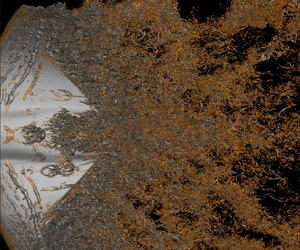Published online by Cambridge University Press: 16 May 2023

Flow around a tethered model of a swimming batoid fish is studied by using the wall-modelled large-eddy simulation in conjunction with the immersed boundary method. A Reynolds number ( $Re$) up to 148 000 is chosen, and it is comparable to that of a medium-sized aquatic animal in cruising swimming state. At such a high
$Re$) up to 148 000 is chosen, and it is comparable to that of a medium-sized aquatic animal in cruising swimming state. At such a high  $Re$, we provide, to the best of our knowledge, the first evidence of hairpin vortical (HV) structures near the body surface using three-dimensional high-fidelity flow field data. It is observed that such small-scale vortical structures are mainly formed through two mechanisms: the leading-edge vortex (LEV)–secondary filament–HV and LEV–HV transformations in different regions. The HVs create strong fluctuations in the pressure distribution and frequency spectrum. Simulations are also conducted at
$Re$, we provide, to the best of our knowledge, the first evidence of hairpin vortical (HV) structures near the body surface using three-dimensional high-fidelity flow field data. It is observed that such small-scale vortical structures are mainly formed through two mechanisms: the leading-edge vortex (LEV)–secondary filament–HV and LEV–HV transformations in different regions. The HVs create strong fluctuations in the pressure distribution and frequency spectrum. Simulations are also conducted at  $Re=1480$ and 14 800 to reveal the effect of Reynolds number. Variations of the flow separation behaviour and local pressure with
$Re=1480$ and 14 800 to reveal the effect of Reynolds number. Variations of the flow separation behaviour and local pressure with  $Re$ are presented. Our results indicate that low-
$Re$ are presented. Our results indicate that low- $Re$ simulations are meaningful when the focus is on the force variation tendency, whereas high-
$Re$ simulations are meaningful when the focus is on the force variation tendency, whereas high- $Re$ simulations are needed when concerning flow fluctuations and turbulence mechanisms.
$Re$ simulations are needed when concerning flow fluctuations and turbulence mechanisms.